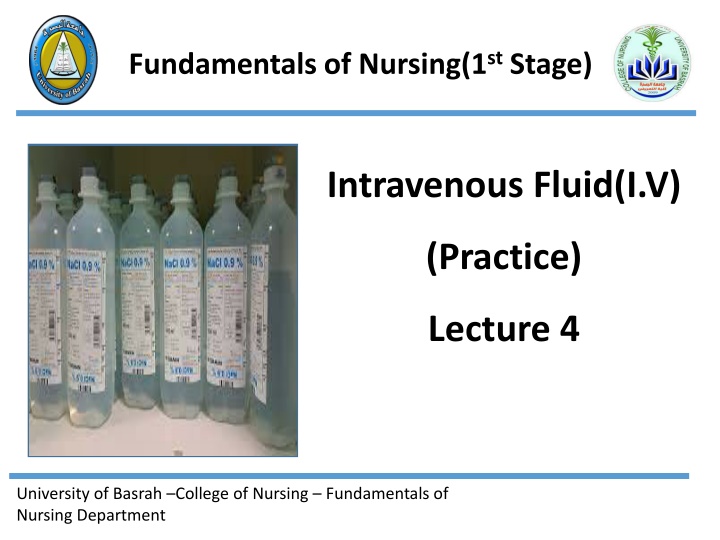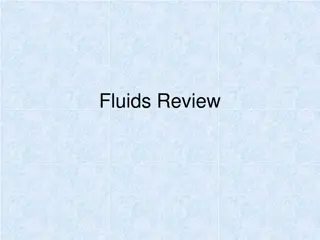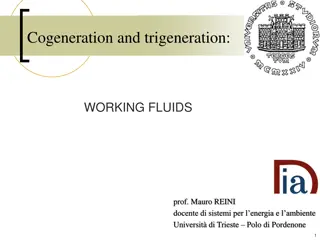
Intravenous Fluids: Understanding IV Solutions
Introduction to intravenous fluid therapy and the responsibilities of healthcare professionals in prescribing, administering, and monitoring IV solutions. Learn about the types of IV fluids, including crystalloids, and their classifications based on tonicity. Understand the importance of evaluating patient orders before IV administration.
Download Presentation

Please find below an Image/Link to download the presentation.
The content on the website is provided AS IS for your information and personal use only. It may not be sold, licensed, or shared on other websites without obtaining consent from the author. If you encounter any issues during the download, it is possible that the publisher has removed the file from their server.
You are allowed to download the files provided on this website for personal or commercial use, subject to the condition that they are used lawfully. All files are the property of their respective owners.
The content on the website is provided AS IS for your information and personal use only. It may not be sold, licensed, or shared on other websites without obtaining consent from the author.
E N D
Presentation Transcript
Fundamentals of Nursing(1stStage) Intravenous Fluid(I.V) (Practice) Lecture 4 University of Basrah College of Nursing Fundamentals of Nursing Department
Introduction A relatively common form of therapy for handling fluid disturbances is the use of infused intravenous solutions. The physician or other licensed health care professional with prescriptive privileges is responsible for prescribing the type and volume of solution to be administered. The nurse is responsible for initiating, monitoring, and discontinuing the therapy. The nurse is also responsible for critically evaluating all patient orders prior to administration.
Definition of I.V fluids Chemically prepared solutions that are administered to a patient through the I.V site. Types of I.V fluids 1- Colloids (Dextran, Hetastarch, Albumin) 2- Blood products ( Fresh frozen plasma (FFP). Plasma protein fraction (PPF). Packed red blood cells (PRBCS). Whole blood ) 3- Crystalloids
Crystalloids Crystalloid Solutions is the primary fluid used for prehospital I.V therapy. Crystalloids contain electrolytes (e.g sodium, potassium, calcium, chloride) but lack the large proteins and molecules found in colloids. Crystalloids come in many preparations and are classified according to their tonicity"
A crystalloids tonicity: describes the concentration of electrolytes dissolved in the water, as compared with that of body plasma fluid surrounding the cells. When the crystalloid contains the same amount of electrolytes as the plasma, it has the same concentration and is referred to as isotonic concentration.
If a crystalloid contains more electrolytes than the body plasma, it is more concentrated and referred to as hypertonic concentration. when a crystalloid contains fewer electrolytes than the plasma, it is less concentrated and referred to as hypotonic concentration.
Common crystalloids 0.9% Sodium Chloride also called Normal Saline (NaCl) Type: Isotonic Not desirable as routine maintenance solution because it provides only Na+ and Cl , which are provided in excessive amounts. Uses 1. May be used to expand temporarily the extracellular compartment if circulatory insufficiency is a problem; 2. Used to treat hypovolemia, metabolic alkalosis, hyponatremia, hypochloremia,diabetic ketoacidosis (DKA), hypercalcemia 3. Used with administration of blood transfusions
Nursing considerations Can lead to overload Use with caution in patients with renal failure, heart failure or edem.
Dextrose 5% in water (D5W) Type: Isotonic Supplies about 170 cal/L and free water (contains 50 g of glucose) Uses Fluid loss Dehydration Hypernatraemia
Nursing considerations 1. 2. Can cause fluid overload Contraindicated in head injury because it may result in an increased intracranial pressure. Use with caution in renal and cardiac patients. Should not be used in excessive volumes because it does not contain any sodium; thus the fluid dilutes the amount of sodium in the serum. Brain swelling, or hyponatremic encephalopathy, can develop rapidly and cause death unless it is promptly recognized and treated. 3. 4. 5.
Lactated Ringers solution Type: Isotonic Contains multiple electrolytes in about the same concentrations as found in plasma Uses: Hypovolemia Burns Fluid lost as diarrhea, acute blood loss. Useful in treating metabolic acidosis
Lactated Ringers solution Nursing considerations Don t used for renal failure patient because it contains potassium and can cause hyperkalemia.
0.45% Sodium Chloride ( half strength saline ) Type: Hypotonic A solution that provides Na+, Cl , and free water Uses: 1. 2. Used as a basic fluid for maintenance needs Often used to treat hypernatremia (because this solution contains a small amount of Na+, it dilutes the plasma sodium while not allowing it to drop too rapidly 3. Gastric fluid loss from NG tube or vomiting 4. Water replacement 5. DKA Nursing considerations May cause cardiovascular collapse increased intracranial pressure.
Dextrose 5% in normal saline Type: Hypertonic Uses: Temporary treatment from shock Nursing considerations: Contra-indicated for cardiac or renal patients.
Dextrose 10% in water (D10W) Type: Hypertonic Uses: 1. Water replacement 2. Conditions where some nutrition with glucose is required Nursing considerations: Monitor blood sugar levels.
Type: Hypertonic Uses: hyponatremia Nursing considerations: administer slowly and cautiously because it can cause intravascular volume overload and pulmonary edema.
Mannitol fluid Indications 1. Used in the treatment of patients in the early, oliguric phase of acute renal failure 2. Cerebral edema Contraindications 1. Severe renal disease 2. Pulmonary edema 3. Active intracranial bleeding
Complications of I.V Therapy 1-Local complications at the site including: Extravasation Phlebitis/Thrombophlebitis Haematoma Infection 2- Fluid overload 3-Electrolyte imbalance 4-Transfusion reactions 5- Air embolus






















